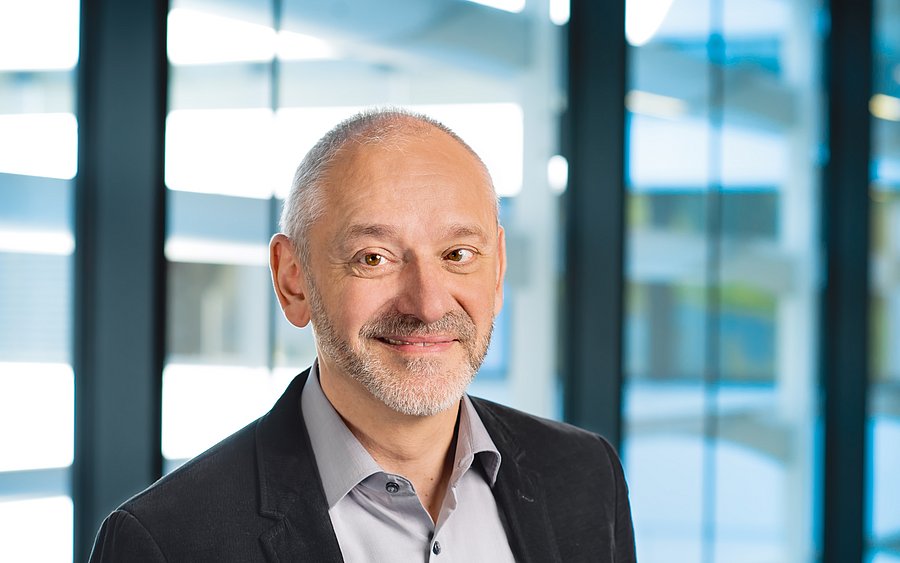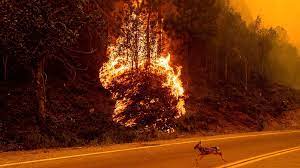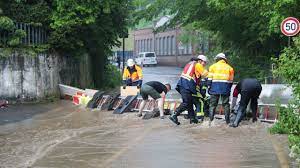
Extreme weather events
Prof. Dr.-Ing. Frank Fiedrich / Civil protection, disaster relief and property safety
Photo: Bo Tackenberg
"In the medium term, we can also expect an increase in extreme weather events here in the Bergisches Land"Urban Wildland Interface
Prof. Dr. Frank Fiedrich on protective measures in case of crisis and disaster
Devastating forest fires in Greece and Turkey, tornadoes in the United States, volcanic eruptions on the Canary Islands or floods like the recent ones in North Rhine-Westphalia and Rhineland-Palatinate worry people everywhere more and more. Climate change is here, experts have known for years, but protective measures could be optimised, knows Frank Fiedrich, Chair of Civil Protection, Disaster Relief and Property Safety at the Faculty of Mechanical Engineering and Safety Engineering at Bergische Universität. "We are slowly learning that this can also happen in our country," says Fiedrich, "and the question of self-protection of the population is currently a major topic both in practice and in research." For the time being, we are still talking about future scenarios, but forest fires, drought risks and heavy rainfall events will increase in the medium term, the scientist emphasises. With regard to forest fires, which have affected many places in Europe in recent years, there are both national and international mechanisms that take effect when a region or country is overwhelmed by such a dangerous situation. "At the European level, it is the EU Civil Protection Mechanism, through which additional resources can be requested from other EU states. At the national level, supra-local assistance is similarly regulated in German civil protection." Forest fire threats have been a focus of the European Union for years, Fiedrich explains, saying, "The EU as a whole is also aware that we are underserved in certain areas and therefore supports the procurement of additional forest firefighting resources through the new rescEU programme."

Urban Wildland Interface
The dream of many people to own a house in the countryside, with best forest access for daily jogging rounds or the walk to the dog, could also become a dangerous dream in times of climate change. "Where nature and forests come together with people, you have to be especially careful," the scientist explains. In the Anglo-American world, this is also referred to as the Urban Wildland Interface. This is the name given to the interface between undeveloped nature and populated areas. If one assumes that the danger of forest fires will increase, then one must also take appropriate precautions there. Within a plot of land, this means larger open spaces with certain distances as well as a thinner settlement to the actual forest vegetation, because, he emphasises: "In the medium term, we can also expect more pronounced periods of drought here in terms of climate hazards.
Self-protection through being informed
In the Corona crisis, one could see very well how the population was informed by official bodies and also made themselves smart. There are brochures both in print and digitally, but for Fiedrich, communication means above all becoming proactive. The scientist sees considerable potential for improvement on the part of the state, e.g. in the form of events that could take place in schools or that are directed at the population in whatever active form that has an impact on the public. There is also a need to catch up with regard to a stronger presence in the social media. The flood events in Germany had already made people very aware and this awareness could be strengthened. Other offers, such as the nationwide warning day or the international day of disaster prevention, are less accepted individually, not least because major damage events have been rather rare in our country so far. "If, for example, the power fails in India, it is something different than if such an event occurs in Germany. The population there is more prepared for something like this to happen and is therefore better able to cope with such outages," says the expert.

Combat with combined forces
According to the forest fire statistics of the Federal Office for Agriculture and Food, a total area of 62 ha burned in 2020. In 1919, it was still 27 ha. "Here in Wuppertal, the city and the Wuppertal fire brigade would be primarily responsible in the event of a disaster," Fiedrich explains. "Crisis teams would be formed to deal with the situation and, if necessary, experts would be called in." These could then be, for example, the Technical Relief Agency or the Forestry Office, he explains. In the event of a natural disaster or a particularly serious accident, the German Armed Forces may also be called in to provide administrative assistance. Today's emergency response teams work primarily on the basis of knowledge gained from the largest German forest fire in the Lüneburg Heath in 1975, the researcher knows. "We had the largest forest fire in German history there at that time. More than 75 square kilometres burned down within two weeks. More than 32,000 forces were deployed and many deficiencies in the cooperation of the emergency services were identified. We have learned from this! They are better prepared and there are appropriate structures."
In Germany, a distinction is also made between the operational-tactical staff for command and the administrative-organisational administrative staff, which is responsible for those measures that have to be taken by an administration due to legal requirements, financial responsibilities or political responsibility. Fiedrich questions whether these structures still fit today with every new project.
Human factor of insecurity
Many fires are caused by arson. A discarded cigarette, a clandestine barbecue or malicious ignition. Humans as a factor of insecurity? How does one deal with these anthropogenic hazard potentials in hazard prevention at all? "Man as a cause has always played a role. You have to distinguish between malicious and negligent behaviour," says Fiedrich. Negligence can be countered with information campaigns or well-placed signs. This would generate awareness among the population, although the scientist emphasises that preventing arson in forest and nature conservation areas is unfortunately often not possible, because the size of the area alone means that there cannot be good monitoring there. But the human factor is always taken into account in hazard and risk analyses, he says.
Helping hands
The fact that people are not only seen as risk factors in analyses, but can also act as potential support in crises and disasters, is one of the things Fiedrich is investigating in a new, three-year project. Under the acronym Sokapi-R (Development of a Social Capital Radar for Social Space-Oriented Civil Protection), the aim is to study communities that, through a high level of cohesion, strong trust and commonly shared values, show broad behaviour geared towards help and support in crises and disasters. "It's about trying to better understand the neighbourhoods and support capacities that are inherent in each city." The project aims to elicit neighbourhood networks and initiatives and examine their influence on crisis resilience. It will also focus on the disadvantage aspects of vulnerable groups. Together, this can result in a situation picture that must be taken into account in the work of civil protection. "For this purpose, we could develop a kind of dashboard for Wuppertal, i.e. a visualisation of data, with the help of which we can overlap relevant data and identify potential for improvement. Because for good crisis management, the cooperation of the population, response and volunteer organisations as well as neighbourhood networks and the like plays a major role."
The awareness of how to deal with crises is changing, Fiedrich notes, and the better one understands the social structures and the associated cohesion of the communities, the more targeted one can plan protective measures for the population.
Uwe Blass (interview of 25.10.2021)
Prof. Dr.-Ing. Frank Fiedrich is head of the Department of Civil Protection, Disaster Relief and Facility Security at the Faculty of Mechanical Engineering and Safety Engineering at Bergische Universität.
